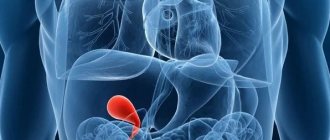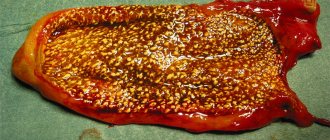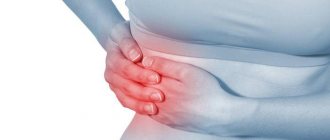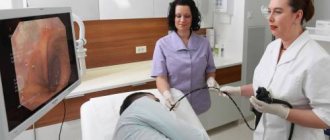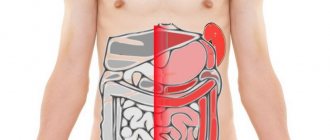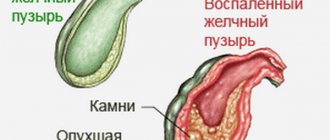Causes
Perforation of the bladder most often occurs as a result of chronic inflammation or the presence of stones that injure the organ. The walls become thinner, and foci of necrosis appear due to the inflammatory process. Bile from the organ enters the abdominal cavity, causing peritonitis. Pus accumulates in the inflamed bladder, which causes stretching, thinning, and then rupture of the walls of the organ. If the inflammatory process is not treated and the symptoms are ignored, deformation of the organ and loss of function occurs.
Perforation of the gallbladder can also occur as a result of injury:
- knife wound;
- impact or accident;
- unsuccessful surgery;
- presence of sharp stones inside.
Congenital curvature, irregular organ shape, and inflammatory process increase the likelihood of rupture. A healthy gallbladder is elastic and does not protrude beyond the ribs that protect it from shock, so it is not easy to injure.
In old age, ruptures occur more often due to decreased elasticity of the organ. With cholelithiasis, “bedsores” appear on the walls, which also increases the risk of ulceration and perforation.
Diagnosis of gallbladder rupture
There are several ways to determine that the gallbladder has burst:
- collection of patient complaints;
- blood and urine tests;
- performing ultrasound;
- diagnostic laparoscopy.
After interviewing the patient and finding out whether he has chronic gallbladder diseases, the doctor prescribes a set of tests.
A blood test shows signs of intoxication and an acute infectious process - these include an increase in ESR and an increase in the number of leukocytes.
An ultrasound determines the presence of fluid in the abdominal cavity, and during the examination you can also see the area where the rupture occurred.
Laparoscopy is recommended when it is not possible to detect the source of deterioration in the patient’s health - the procedure is advisable if, based on the symptoms, a vesicointestinal fistula can be suspected.
Because the patient's condition rapidly deteriorates and a rupture can be fatal, it is important to quickly determine whether the gallbladder has ruptured.
Diagnosis
Sometimes the symptoms of a ruptured gallbladder are confused with acute cholecystitis or a stone stuck in the bile duct. But the pain during perforation is usually more acute and constantly increases. There is an increase in body temperature and a sharp deterioration in general condition. The doctor, upon palpation, identifies symptoms of an “acute abdomen.”
The general picture and intensity of the signs of perforation depend on the form of the disease - it can be acute, chronic or subacute. If symptoms are vague, an ultrasound or laparoscopic examination of the abdominal cavity is performed. The examination helps to detect a violation of the outflow of bile, the presence of stones and pus, fistulas, and abscesses. A blood test reveals an increase in leukocytes and ESR, stab neutrophils. When performing a liver test, an increase in alkaline phosphatase, ALT, AST and bilirubin is noted.
What symptoms accompany organ rupture?
The symptoms of each form of gallbladder rupture will differ. So, let's look at the distinctive features.
Acute form of the disease
Acute perforation occurs together with the development of acute cholecystitis, and is accompanied by the following symptoms: increased general temperature, vomiting, nausea, severe pain syndrome that covers the right hypochondrium, a change in the shade of the mucous membranes to a yellow color.
Decreased blood pressure
If the gallbladder bursts, it can cause a subhepatic abscess, which is characterized by fever, chills, a feeling of heaviness in the right hypochondrium, as well as pain in this area. In addition to such symptoms, an increase in heart rate and a decrease in blood pressure are also observed.
With the development of a chronic form of the pathology, the appearance of fistulas in the biliary tract is observed, which cause the following symptoms: the development of acute cholangitis (inflammation of the bile ducts), fever, general malaise, vomiting, nausea, abdominal pain, itching of the skin. If a stone enters the digestive tract, intestinal obstruction is diagnosed.
Acute form of the disease
Symptoms and treatment
Gallbladder perforation is a life-threatening condition requiring immediate hospitalization and surgery. The surgeon removes the contents of the gallbladder from the abdominal cavity and takes disinfection measures. The organ itself must be sutured at the site of the rupture. If there are a large number of stones or significant deformation, complete removal of the gallstone may be necessary.
In this article, we reviewed clinics that perform such operations and analyzed prices for gallbladder removal
Acute rupture
The patient's condition is characterized by sharp pain in the right side and a rise in temperature. An acute rupture occurs due to a sharp increase in pressure on the walls of the bladder as a result of the accumulation of pus or the presence of a stone. The pain constantly increases, and when the contents of the bladder enter the abdominal cavity, symptoms of peritonitis appear:
- nausea, vomiting;
- rapid increase in temperature;
- aversion to food;
- weakness;
- sometimes jaundice occurs.
This is the most dangerous form of perforation, in which the lack of medical attention can cause death within a few hours.
Subacute rupture
The patient develops a subhepatic abscess - a focus of purulent inflammation at the site of the rupture. The symptoms are the same as in the acute form, only less pronounced. But this condition is no less dangerous, since sepsis can occur when an infection from the gallbladder enters the blood. In a hospital setting, the abscess is removed, the further spread of infection is combated with antibiotics, and the underlying disease that caused the inflammation is treated.
Chronic rupture
It is characterized by the formation of fistulous tracts from the gallbladder to neighboring organs - the stomach or duodenum. This condition can last a long time, causing stones and bladder contents to enter the intestines and stomach. As a result of the reverse movement, bacteria from the intestines can be thrown into the gallbladder. Symptoms are not always pronounced, but are usually observed:
- attacks of nausea and vomiting;
- pain in the right side;
- yellowness and itching of the skin;
- periodic or constant increase in temperature.
Exacerbation of the condition causes the transfer of microbes into the gallbladder from the intestines and the development of infection. Often such a gap is detected only during examination by ultrasound or laparoscopy.
Symptoms of the disease
There are characteristic symptoms for each form of pathology.
| Acute |
|
| Subacute |
|
| Chronic |
|
Symptoms of the acute form appear up to 1.5 hours. The nature of the symptoms is slowly subsiding - corrosion of the nerve endings at the site of damage.
Chronic - manifestations are provoked by: the entry of pathogenic microflora from the gastrointestinal tract, lifting weights, eating heavy food, increased bile acidity.
For positive prognosis and effective treatment, timely diagnosis is necessary, which is based on prompt compilation of anamnesis. In this case, analysis and comparison of symptoms characteristic of gallbladder perforation play an important role. For each form, the symptoms of gallbladder rupture are separate. It's worth getting into them.
Prevention
To prevent rupture of the gallbladder, timely treatment of inflammatory processes and measures against the formation of stones are necessary. Symptoms of inflammation of the gallbladder (digestive disorders, pain in the right side, nausea) require timely consultation with a doctor and treatment.
To combat inflammation, antimicrobial, choleretic and antispasmodic drugs are prescribed. If stones are present, they are first dissolved by injecting medications directly into the organ or taking them orally in tablets.
If there are a significant number of stones that are not amenable to conservative therapy, removal of the gallbladder is indicated. The operation helps to avoid a life-threatening condition that can occur at any time due to inflammation and overcrowding of the organ with stones.
Biliary peritonitis
This condition is considered prognostically unfavorable, since postoperative mortality can reach 45%. Biliary peritonitis is quite difficult to diagnose in the early stages. In addition to perforated peritonitis, perforated and postoperative forms are also observed in surgical practice.
Typical sites of perforation are the neck and bottom of the organ. The initial stage of pathology lasts from several hours to a day. During this period, local peritonitis turns into a diffuse form. Patients complain of pain, nausea and vomiting. The patient is covered in cold, sticky sweat and is unable to take a deep breath, so his breathing is rapid and shallow. In rare cases, body temperature remains within normal limits, but more often it rises. The pulse is increased and the blood pressure is slightly reduced. Palpation of the abdomen determines the protective tension of the abdominal wall muscles.
The next stage of bile peritonitis is toxic. It usually occurs within a day from the onset of the development of the pathology and can continue for another 1–2 days. Pronounced symptoms of the toxic stage:
- constant thirst;
- vomiting, called “fecal” (vomit is dark in color and has a foul odor);
- increased sweating;
- pale skin;
- sharpening of facial features;
- acrocyanosis;
- frequent shallow breathing, rhythm disturbance;
- decreased blood pressure;
- tachycardia;
- dry tongue with a dark coating;
- positive Shchetkin-Blumberg symptom.
Patients are conscious, but there may be attacks of delirium and uncontrolled aggression. Next comes the stage of irreversible changes. The condition of patients during this period of time is extremely serious:
- confusion;
- pale and yellow skin;
- limbs have a bluish tint;
- shallow breathing;
- pulse and blood pressure are barely audible;
- Palpation of the abdomen causes virtually no pain.
There is no clear distinction between the stages of peritonitis due to a burst gallbladder, so it is important to diagnose the pathology and provide assistance to the patient as early as possible. This will improve the favorable prognosis.
Acute form
The acute form of the development of pathology is characterized by symptoms similar to acute cholecystitis, which is often the cause of perforation, including:
- general signs of inflammation: body temperature rises sharply, the patient refuses to eat, complains of nausea and frequent vomiting;
- the skin and partially mucous membranes acquire a yellow tint;
- acute pain is recorded in the area of the right hypochondrium; upon palpation, the pain intensifies; the condition and reaction of the skin and muscles at the site of pain are similar to typical peritonitis.
